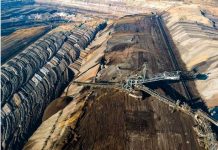by Shaun Polczer
Smart money isn’t making big investments in natural gas. It’s making HUGE investments.
One of the industry’s most fiscally conservative — and notoriously cheap — operators, CNRL (CNQ-NYSE/TSX; $36) reportedly bought Devon Canada’s entire conventional oil and gas—but mainly gas—assets for $3.1 billion; reportedly sight unseen. It didn’t even wait go into the data room, pre-empting the entire process with its all-cash offer.
We’re talking 2.2 million undeveloped acres, and another 2.7 million acres of freehold royalty lands, scattered across a diagonal line running from northern BC to southeast Saskatchewan.
It’s conspicuously contrarian for a company that since 2008 has shut in money losing wells and let total gas production fall by two-thirds. Even more curious is the fact that CNRL in January shelved plans to dump 6.7 trillion cubic feet of Montney reserves when it couldn’t get the price it wanted — presumably more than the $30,000 per flowing barrel it was willing to pay Devon, which isn’t exactly cheap.
This deal could unlock the doors to a lot more M&A in the natural gas market. There is now a firm price both buyers and sellers can start from to get the games going.
The timing of those decisions will be set by the gas price. Though Henry Hub spot prices spiked in the last week of February, at $6.50 US per million British thermal units (Btu), nobody — not even CNRL — is predicting a real turnaround in natgas prices until the first LNG export terminals in Canada and the US kick in after 2016.
But CNRL obviously sees something in gas market fundamentals others don’t.
Storage overhang melts in freezing cold
Aside from the cold, the last week of February was notable for extremely bullish natural gas storage numbers. According to the US government’s Energy Information Administration (EIA) storage levels are a trillion cubic feet (tcf) lower than they were last year and 39% below the five-year average. The EIA is projecting winter storage to bottom out below 1 tcf for the first time since 2003. That’s what a polar vortex will do.
Summer’s going to come eventually, so it would be remiss to think short term prices are going to stay aloft, but the trend is heading in the right direction. The EIA expects the US to consume in excess of 70 billion cubic feet per day in 2014 for only the second time since 2013, after seeing spikes in excess of 135 bcf/d in January.
The demand side is looking equally bullish. Later this year the Obama administration will enact the first restrictions on coal-fired power, which will increase the call on gas. He’s also expected allow LNG exports through the Gulf of Mexico, which will also support prices over the longer term.
Most of it will come from domestic plays like the Marcellus, which the EIA projects will become the largest gas producing region in the US this year.
But even as overall US imports from Canada continue to fall, Washington state, Idaho, Oregon and parts of California continue to rely on Canada for 65% of the gas consumed in the Pacific Northwest. Some 6.5 bcf/d arrives from northeast B.C. via Spectra’s Westcoast pipeline that runs from Fort Nelson to the US border.
According to Housely Carr with RBN Energy in Houston, extra pipeline capacity from Canada will be needed to meet an extra 2.1 bcf/d of new gas demand in the region, roughly a 30% increase from present levels.
This time the story isn’t coal. Hydro production is threatened by drought and low reservoir levels experts attribute to long-term climate change. Consequently electricity producers are switching to gas as a backup, and many are using it as their primary fuel source.
Tying it together
That’s good news for gas producers in B.C. that are tied into west coast pipelines. CNRL included. And it should provide some welcome relief for struggling juniors, who haven’t been able to raise the capital needed to even bid on Devon’s land.
With CNRL and Devon setting a new benchmark for deals, many companies are trading below the value of their land holdings, setting the stage for a new round of M&A activity.
Artek Exploration is a case in point. Following its latest reserve report, the company is claiming net asset value of $5.43 a share for its 150,000 acres in northern Alberta and B.C. versus a share price of about $3.50. However it has gained as much as 60 cents since the Devon deal was announced, to hit a new 52-week high of $4.08.
Robert Pare of Clarus Securities is the most bullish analyst covering the company, with an estimated after tax asset value of $8.64 per share and a 12-month target price of $6.50.
Other maligned producers are in a good spot too. After more than doubling in 2013, TSX-Venture listed Storm Resources continues to make new all-time highs just below $5. It could either be a tempting prize or a potential acquisitor in this environment.
But juniors aren’t the only ones to benefit. Bellwether intermediate Birchcliff Resources has gained nearly $2, or more than 25% since mid-February, and is now trading around $10. That in turn sparked a round of analyst upgrades; TD Securities upgraded the company to ‘buy’. Scotia Bank upped its target to $12 with a ‘sector outperform’ and CIBC tacked in at $11.75.
Birchcliff is notable because it put itself up for sale three years ago and hasn’t been able to find a buyer. CEO Jeff Tonken has made no secret of his intentions to sell the company when the price is right. That time could be now.
But like the weather, that could change in a hurry. The bigger question is whether this is a blip or a long term trend. The smart money thinks it’s here to stay.
To understand CNRL’s newfound enthusiasm for gas, a little history lesson is in order. Oklahoma-based Devon made a big splash into Canada in 2002 by buying Anderson Exploration for $4 billion, a tidy sum in those days. Fronted by the legendary JC Anderson, his namesake was notable for its takeover of Home Oil in 1995.
For those who don’t know, Home inherited the mineral titles of Hudson’s Bay Oil and Gas, which in turn inherited them from Radisson, Gooseberries, and King Charles II way back in 1670. CNRL didn’t need to go into the data room to know that these are literally, the Crown Jewels.
Most energy investors in Canada are aware that the Canadian Pacific Railroad freehold lands that Encana has, it now plans to spin into a separate entity.
In fact, the Hudson’s Bay titles — which formed the basis for the Canadian National Railroad — are just as big. It is likely that CNRL will follow similar feats of financial engineering with a spinoff of Devon’s so-called ‘fee simple’ royalty lands later this year.
That spinoff would effectively double CNRL’s existing royalty revenue to $150 million by 2015.
Combined with its own freehold lands, it will be at least as large as Encana’s plans for its Clearwater IPO, at 5 million acres or more.
That still leaves 2.2 million acres that CNRL would need to drill at some point, if only to keep the leases. It could bring in a foreign partner to offset costs, but that’s not CNRL’s style — it likes to keep 100% control of everything and set its own pace.
Devon’s 86,600 boe/d of production — including 343 million cubic feet a day of gas — is 72% operated, giving the fiscal and operational flexibility to respond to changing market signals.








